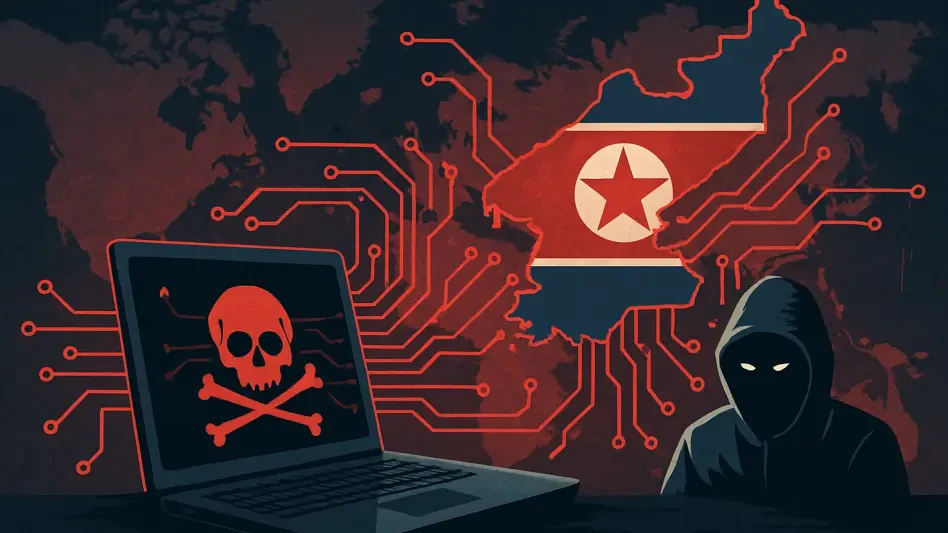In an era where digital warfare shapes global power dynamics, a staggering statistic emerges: North Korea accounts for nearly one-fifth of all nation-state cyber activity in the second and third quarters of this year, signaling a profound shift in the cybersecurity market. State-sponsored hacking is no longer a peripheral concern but a core driver of risk for industries worldwide, with telecommunications and technology sectors reeling from relentless attacks and the implications rippling across economies and geopolitics alike. This analysis explores the market trends behind North Korea’s cyber ascendancy, dissecting the tactics, targets, and broader patterns that define this threat landscape. It aims to equip stakeholders with actionable insights into current challenges and future projections, shedding light on how businesses and governments can navigate an increasingly hostile digital environment.
Unpacking the Market Trends: North Korea’s Cyber Supremacy
Tactical Evolution: Stealth as a Market Disruptor
North Korea’s cyber operations have redefined the market for digital threats, with state-sponsored groups employing sophisticated evasion tactics that challenge traditional defense mechanisms. Notably, techniques such as “living off the land”—using legitimate tools like Windows Command Prompt and PowerShell—have surged, allowing attackers to mask malicious activity within routine network traffic. This shift toward stealth over overt malware deployment has created a niche demand for advanced behavioral detection tools, as conventional antivirus solutions struggle to keep pace. The market implication is clear: cybersecurity vendors must pivot to anomaly-based systems, while organizations face heightened costs to overhaul their security architectures.
Target Sectors: Telecommunications at the Epicenter
The telecommunications sector, absorbing 71% of nation-state attacks, stands as the primary battleground in this cyber market. Other industries, including technology, transportation, business services, and finance, also face significant exposure, reflecting a diversified risk portfolio for North Korean hackers. This concentration on critical infrastructure underscores a strategic intent to disrupt essential services, amplifying the demand for sector-specific security solutions. As telecom firms scramble to fortify their networks, the market sees a spike in investments in specialized firewalls and intrusion prevention systems tailored to high-stakes environments, signaling a long-term growth area for cybersecurity providers.
Geographic Hotspots: Turkey and Beyond
Geographically, the market for cyber defense is unevenly strained, with Turkey emerging as the most targeted nation, accounting for 33% of detections, largely due to its telecom vulnerabilities and strategic position bridging Europe and Asia. The United States follows at 24%, with attacks spread across multiple sectors, highlighting a broader risk distribution. These regional disparities drive a fragmented market response, where localized threat intelligence and region-specific regulatory compliance become critical. Vendors offering geo-tailored solutions are likely to see increased traction, as businesses in high-risk areas seek customized protections against state-driven cyber campaigns.
Projections: The Future Cyber Threat Market
Rising Sophistication and Technological Leverage
Looking ahead from 2025 to 2027, the market for nation-state hacking is poised to grow in complexity, with North Korea likely to maintain its lead through enhanced tactics. The broader trend of moving away from traditional malware toward evasion-focused strategies is expected to accelerate, fueled by emerging technologies like AI-driven attack automation. This evolution will pressure cybersecurity firms to innovate rapidly, creating a competitive race for AI-integrated defense platforms. Additionally, economic sanctions on rogue states may further incentivize cyber operations as a revenue stream, expanding the market for illicit digital activities and necessitating robust international countermeasures.
Collaborative Threats and Market Consolidation
Another projection shaping the cyber threat market is the potential for increased collaboration among state-sponsored actors, sharing tools and expertise to amplify their impact. Such alliances could consolidate smaller players into larger, more formidable threats, challenging the fragmented nature of current defense markets. Regulatory frameworks are anticipated to lag behind these developments, pushing private sector entities to bear the brunt of innovation costs. This dynamic may spur mergers and acquisitions among cybersecurity firms, as smaller vendors seek scale to address the escalating demands of a unified threat landscape.
Sectoral Shifts and Investment Opportunities
Future market trends also point to a sustained focus on critical infrastructure, with telecommunications likely to remain a prime target due to its systemic importance. However, emerging sectors like renewable energy and smart cities could see rising threats as digital integration deepens, opening new niches for security solutions. Investors in the cybersecurity space should note the potential for high returns in adaptive technologies, such as zero-trust architectures and endpoint detection systems, which are well-positioned to address the nuanced threats posed by state actors. The market’s trajectory suggests a dual focus on prevention and resilience, reshaping budget allocations across industries.
Reflecting on the Past: Strategic Takeaways and Next Steps
Looking back on the insights from the second and third quarters of this year, North Korea’s dominance in the cyber threat market revealed a sophisticated interplay of stealth tactics and geopolitical strategy. The heavy targeting of telecommunications and strategic regions like Turkey underscored the calculated nature of these campaigns, while the shift toward malware-free attacks highlighted a maturing threat ecosystem. These findings painted a picture of a market under strain, where traditional defenses often fell short against state-sponsored ingenuity.
Moving forward, stakeholders must prioritize layered security approaches, integrating anomaly detection software and zero-trust models to counter subtle intrusions. Businesses should also invest in rigorous access controls for privileged accounts and foster collaboration between security operations centers and IT teams to spot deviations early. Beyond immediate tactics, a broader industry push for international threat-sharing platforms could mitigate the risks of collaborative state attacks, ensuring that isolated efforts evolve into collective resilience. These steps, grounded in the lessons of recent quarters, offer a pathway to not just react to, but anticipate and outmaneuver the next wave of digital threats.








